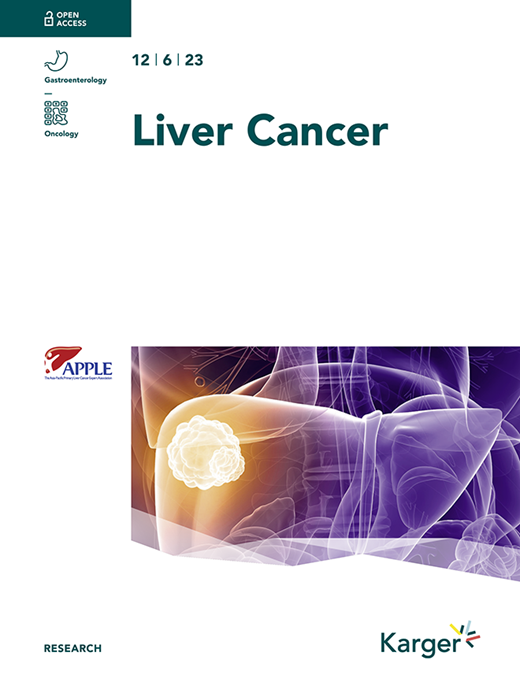atezolizumab / bevacizumab在肝细胞癌和肝功能受损患者中的安全性和有效性:一项系统回顾和荟萃分析
IF 9.1
1区 医学
Q1 GASTROENTEROLOGY & HEPATOLOGY
引用次数: 0
摘要
& lt; b> & lt; i>背景:& lt; / i> & lt; / b>atezolizumab/bevacizumab治疗Child-Pugh B型肝细胞癌(HCC)患者的安全性和预后尚未完全确定。& lt; b> & lt; i>目标:& lt; / i> & lt; / b>在这项研究中,我们旨在通过回顾现有数据并通过荟萃分析分析来解决atezolizumab/bevacizumab在Child-Pugh B患者中的安全性和有效性。& lt; b> & lt; i>方法:& lt; / i> & lt; / b>我们比较了atezolizumab/becavizumab治疗不可切除HCC和不同程度肝功能障碍患者的安全性和有效性。本荟萃分析共纳入8项回顾性、非随机、队列研究,共纳入1071例Child-Pugh A和225例Child-Pugh B患者。当可用时,白蛋白胆红素(ALBI)分级也用于评估肝功能。& lt; b> & lt; i>结果:& lt; / i> & lt; / b>11.8%的Child-Pugh A类患者和26.8%的Child-Pugh B类患者出现≥3级不良事件(<i>p</i>= 0.0001),优势比(OR)为0.43(置信区间[CI] 0.21-0.90;& lt; i>术中;/ i>= 0.02)。6个月的无进展生存期(PFS)(4.90±2.08 vs 4.75±2.08个月;& lt; i>术中;/ i>= 0.0004)和12个月(8.83±2.32 vs. 7.26±2.33个月;& lt; i>术中;/ i>Child-Pugh B级患者= 0.002)。Child-Pugh A级患者的客观缓解率(ORR)(219/856, 25.6%)高于Child-Pugh B级患者(25/138,18.1%;& lt; i>术中;/ i>= 0.070),而Child-Pugh A患者获得ORR的概率显著更高(OR 1.79, CI 1.12-2.86;& lt; i>术中;/ i>= 0.02)。Child-Pugh A组和B组患者的中位总生存期(OS)分别为16.8±2.0和6.8±3.2个月(平均差9.06个月,CI 7.01-11.1, <i> </i>, lt;0.0001)。最后,1-2级ALBI患者的OS时间长于3级ALBI患者(8.3±11.4个月vs 3.3±5.0个月),<= 0.0008)。& lt; b> & lt; i>结论:& lt; / i> & lt; / b>在Child-Pugh B级患者中,atezolizumab/bevacizumab的肿瘤疗效是中等的,在这些患者中观察到的较短的PFS和OS与更大的发生治疗相关不良事件的可能性相关,建议非常谨慎和个性化治疗,可能需要ALBI分级的支持。本文章由计算机程序翻译,如有差异,请以英文原文为准。
SAFETY AND EFFICACY OF ATEZOLIZUMAB/ BEVACIZUMAB IN PATIENTS WITH HEPATOCELLULAR CARCINOMA AND IMPAIRED LIVER FUNCTION: A SYSTEMATIC REVIEW AND META-ANALYSIS
Background: Safety and outcome of atezolizumab/bevacizumab in Child-Pugh B patients with hepatocellular carcinoma (HCC) have not been completely characterized. Objectives: In this study, we aimed at addressing safety and efficacy of atezolizumab/bevacizumab in Child-Pugh B patients by reviewing the available data and analyzing them by meta-analysis. Methods: We compared the safety and efficacy of atezolizumab/becavizumab treatment in patients with unresectable HCC and various degrees of liver dysfunction. A total of 8 retrospective, non-randomized, cohort studies were included in this meta-analysis, for a total of 1,071 Child-Pugh A and 225 Child-Pugh B patients. The albumin-bilirubin (ALBI) grade was also used to assess liver function, when available. Results: Grade ≥3 adverse events were observed in 11.8% of Child-Pugh class A and 26.8% class B patients (p = 0.0001), with an odds ratio (OR) of 0.43 (confidence interval [CI] 0.21–0.90; p = 0.02). Progression-free survival (PFS) at both 6 months (4.90 ± 2.08 vs. 4.75 ± 2.08 months; p = 0.0004) and 12 months (8.83 ± 2.32 vs. 7.26 ± 2.33 months; p = 0.002) was lower in Child-Pugh class B patients. A trend toward a higher objective response rate (ORR) was observed in Child-Pugh class A patients (219/856, 25.6%) as compared to Child-Pugh class B patients (25/138, 18.1%; p = 0.070), while the probability of obtaining an ORR was significantly greater in Child-Pugh A patients (OR 1.79, CI 1.12–2.86; p = 0.02). Median overall survival (OS) was 16.8 ± 2.0 and 6.8 ± 3.2 months in Child-Pugh A and B patients, respectively (mean difference 9.06 months, CI 7.01–11.1, p < 0.0001). Lastly, OS was longer in patients with ALBI grades 1–2 than in those with grade 3 (8.3 ± 11.4 vs. 3.3 ± 5.0 months, p = 0.0008). Conclusions: Oncological efficacy of atezolizumab/bevacizumab is moderate in Child-Pugh class B patients, and the shorter PFS and OS associated with the greater likelihood of experiencing treatment-related adverse events observed in these patients suggest great caution and individualization of treatment, possibly with the support of the ALBI grade.
求助全文
通过发布文献求助,成功后即可免费获取论文全文。
去求助
来源期刊

Liver Cancer
Medicine-Oncology
CiteScore
20.80
自引率
7.20%
发文量
53
审稿时长
16 weeks
期刊介绍:
Liver Cancer is a journal that serves the international community of researchers and clinicians by providing a platform for research results related to the causes, mechanisms, and therapy of liver cancer. It focuses on molecular carcinogenesis, prevention, surveillance, diagnosis, and treatment, including molecular targeted therapy. The journal publishes clinical and translational research in the field of liver cancer in both humans and experimental models. It publishes original and review articles and has an Impact Factor of 13.8. The journal is indexed and abstracted in various platforms including PubMed, PubMed Central, Web of Science, Science Citation Index, Science Citation Index Expanded, Google Scholar, DOAJ, Chemical Abstracts Service, Scopus, Embase, Pathway Studio, and WorldCat.
 求助内容:
求助内容: 应助结果提醒方式:
应助结果提醒方式:


